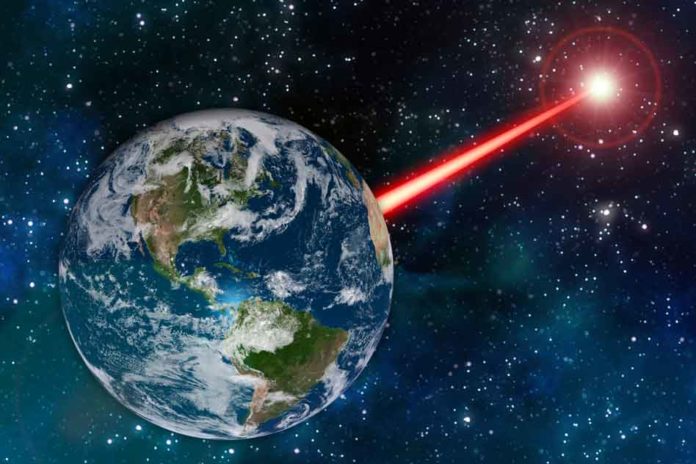According to a new MIT study, if aliens exist somewhere in our galaxy, the existing laser technology could, on a fundamental level, be molded into something of a planetary porch light — a signal strong enough to attract attention from to the extent 20,000 light years away.
Scientists suggest that if a powerful 1-to 2-megawatt laser were engaged through an enormous 30-to 45-meter telescope and pointed out into space, the combination would deliver a infrared radiation strong enough to emerge from the solar energy.
The signal would be detectable to aliens especially if those astronomers live in nearby systems, such as around Proxima Centaur. If they detected the signal, it would be possible to send them a message in the form of pulses similar to Morse code by the same megawatt laser.
The thought of such an outsider drawing in a signal may appear to be implausible, yet the accomplishment can be acknowledged with a combination of advances that exist now and that could be produced in the close term.
James Clark, author of the study said, “If we were to successfully close a handshake and start to communicate, we could flash a message, at a data rate of about a few hundred bits per second, which would get there in just a few years. This would be a challenging project but not an impossible one. The kinds of lasers and telescopes that are being built today can produce a detectable signal, so that an astronomer could take one look at our star and immediately see something unusual about its spectrum. I don’t know if intelligent creatures around the sun would be their first guess, but it would certainly attract further attention.”
Clark has already started investigating the likelihood of a planetary guide as a major aspect of a final project for 16.343 (Spacecraft, and Aircraft Sensors and Instrumentation), a course educated by Clark’s counsel.
He begins with a basic applied structure including a large infrared laser and a telescope through which to additionally focus the laser’s power. His point was to create an infrared signal that was something like 10 times more prominent than the sun’s natural variation of infrared emissions. Such an extraordinary signal would be sufficient to emerge against the sun’s very own infrared signaling any “cursory survey by an extraterrestrial intelligence.”
He thus analyzed combinations of lasers and telescopes of different wattage and size, and found that a 2-megawatt laser pointed through a 30-meter telescope, could deliver a signal strong enough to be effectively distinguishable by stargazers in Proxima Centauri b.
Essentially, a 1-megawatt laser, coordinated through a 45-meter telescope, would create a visible signal in any overview led by space experts inside the TRAPPIST-1 planetary system, around 40 light-years away. Either setup could deliver a, for the most part, a discernible signal from up to 20,000 light-years away.
Both scenarios would require laser and telescope technology that has either already been developed, or is within practical reach. For instance, Clark calculated that the required laser power of 1 to 2 megawatts is equivalent to that of the U.S. Air Force’s Airborne Laser, a now-defunct megawatt laser that was meant to fly aboard a military jet for the purpose of shooting ballistic missiles out of the sky.
He also found that while a 30-meter telescope considerably dwarfs any existing observatory on Earth today, there are plans to build such massive telescopes in the near future, including the 24-meter Giant Magellan Telescope and the 39-meter European Extremely Large Telescope, both of which are currently under construction in Chile.
Like these enormous observatories, a laser reference point ought to be worked on a mountain, to limit the amount of atmosphere the laser would need to infiltrate before radiating out into space.
Clark acknowledges that a megawatt laser would come with some safety issues. Such a beam would produce a flux density of about 800 watts of power per square meter, which is approaching that of the sun, which generates about 1,300 watts per square meter. While the beam wouldn’t be visible, it could still damage people’s vision if they were to look directly at it. The beam could also potentially scramble any cameras aboard spacecraft that happen to pass through it.
Having built up that a planetary reference point is, in fact, practical, Clark at that point flipped the issue and took a gander at whether the present imaging strategies would have the capacity to recognize such an infrared guide on the off chance that it was created by cosmologists somewhere else in the galaxy.
He found that, while a telescope 1 meter or bigger would be equipped for spotting such a reference point, it would need to point in the flag’s correct bearing to see it.
Clark said, “It is vanishingly unlikely that a telescope survey would actually observe an extraterrestrial laser unless we restrict our survey to the very nearest stars.”
According to him, the study will encourage the development of infrared imaging techniques, not only to spot any laser beacons that might be produced by alien astronomers, but also to identify gases in a distant planet’s atmosphere that might be indications of life.
The research, which author James Clark calls a “feasibility study,” appears today in The Astrophysical Journal.
